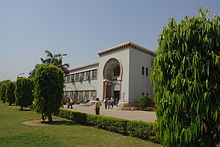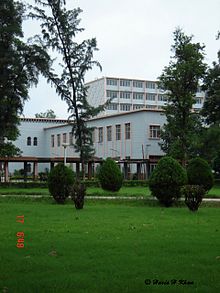- Maulana Azad Library
-
Maulana Azad Library Established 1875 (formally in 1877) Location Aligarh Muslim University, Aligarh Branches 80 Collection Size 1.1 million volumes Website http://www.malibrary.com/ The Maulana Azad Library (Hindi: मौलाना आज़ाद किताब ख़ाना, Urdu: مولانا آزاد کِتاب خانہ Maulānā Azād Kitāb Khāna) is the library of Aligarh Muslim University in Aligarh, India. It consists of a central library and over 80 college and departmental libraries. These libraries cater to the needs of postgraduates and students of professional courses. It is also the largest library in India and second largest in Asia and contains collections of great historical importance.
The Library complex of the University consists of a Central Library and over 80 college/departmental libraries. The libraries of the colleges, institutes and departments, cater to the needs of postgraduates and students of professional courses. The seven-storied building is surrounded by 4.75 acres (19,200 m2) of land in the form of beautiful lawns and gardens. It is the most beautiful building of the University and one of the few very attractive libraries in the country. The Library has about 1,100,000 books.
Contents
History
The Central Library was set up in 1875, when the university was established as a madarsa called Madarsatul Uloom. In 1877, the madarsa became Mohammadan Anglo-Oriental College. Robert Bulwer-Lytton, the viceroy of India, laid the foundation stone, and the library was named after him as the Lytton Library. Many eminent scholars like Gardner Brown, Arnold, Releigh, Horowitz, Storey and Auchtelpone[clarification needed] functioned as honorary librarians in addition to their teaching responsibilities.
The library was named Maulana Azad Library in 1960, when Prime Minister Jawaharlal Nehru inaugurated its present building.
Holdings
The collection consists of books, periodicals, pamphlets, manuscripts, paintings and photographs. The Library performs the functions of a National Library so far as its collection of Oriental manuscripts are concerned. It is because of these rich collections of immense research value that this Library is reckoned among major libraries of the world. The oldest manuscript owned by the library is more than fourteen hundred years old. It is a fragment of the Qur'an transcribed by Hazrat Ali, the fourth caliph of Islam and is written on parchment in Kufi script. Another rare manuscript is the Halnama of Beyazid Ansari, no copy of which is available anywhere else in the world.
The library's collection includes about 1,150,000 books, along with periodicals, pamphlets, manuscripts, paintings and photographs. It aims at supporting students from all departments of the university.
The Library has a sizeable collection of early printed books in various languages. The most outstanding among them is the Latin translation of the celebrated Arabic work on optics, Book of Optics, by Ibn al-Haytham (965-1039) published in 1572.[1] Other important items in the collection include several farmans (decrees) issued by Mughal rulers (including Babur, Akbar, Shahjahan, Shah Alam, Shah Alamgir, and Aurangzeb); a "Shirt" on which the whole Qur'an is inscribed in khafi script. This shirt is believed to have been worn by a warrior of the Mughal army; the Ayurved written in Telugu; and works by Bhasa written in Malayalam on palm leaves.
The Oriental Division of Maulana Azad Library consists of about two lakh[clarification needed] printed books & periodicals including 10,000 items belonging to rare category in Urdu/Persian/Arabic/Hindi & Sanskrit forms the most significant part of the collection. Donations received from great bibliophiles and literary persons are designated as special collections by the names of their donors. The Urdu collection with more than one lakh books on almost all aspects of Indian life and culture forms the largest part of the Oriental Division. A substantial number of rare and out of print publications of 19th century belong to the Scientific Society of Sir Syed Ahmad Khan, Fort William College (Kolkata), Delhi College, Agra College and from the Royal Printing Presses of the courts of Delhi and Oudh.
Among the large collection of Mughal paintings is the painting of Red Blossom, which is the magnum opus of Mansoor Naqqash, the celebrated court artist of the Emperor Jahangir. Some valuable Sanskrit works translated into Persian have also been preserved in the library. Other possessions worth mentioning is the Ayurved in Telugu and the Bhasas in Malayalam script written on palm leaves. Abul Faiz Faizi, an eminent scholar of Akbar's court translated several Sanskrit works into Persian, such as Mahapurana, Bhagavad Gita, Mahabharat and Lilavati, these are also available.
Building and services
The building has seven stories. It is surrounded by 4.75 acres (19,200 m2) of land in the form of lawns and gardens. More than 5,000 students, teachers and other members of the university daily visit the library and utilize its services. The library provides the whole university campus with access to online journals through a well-equipped Computer Lab. Digital resources on many subjects are made accessible through a Digital Resource Centre. All the issuable books in the Library are bar coded for automated check in and check out. The University has established book banks for the benefit of students of certain professional courses.
Footnotes
- ^ Opticæ thesaurus Alhazeni Arabis libri septem, nunc primùm editi: Eiusdem liber De crepusculis & nubium ascensionibus. Item Vitellonis Thuringopoloni libri x / Omnes instaurati, figuris illustrati & aucti, adiectis etiam in Alhazenum commentarijs, à Federico Risnero
Categories:- Aligarh Muslim University
- Academic libraries in India
- 1875 establishments in India
Wikimedia Foundation. 2010.


